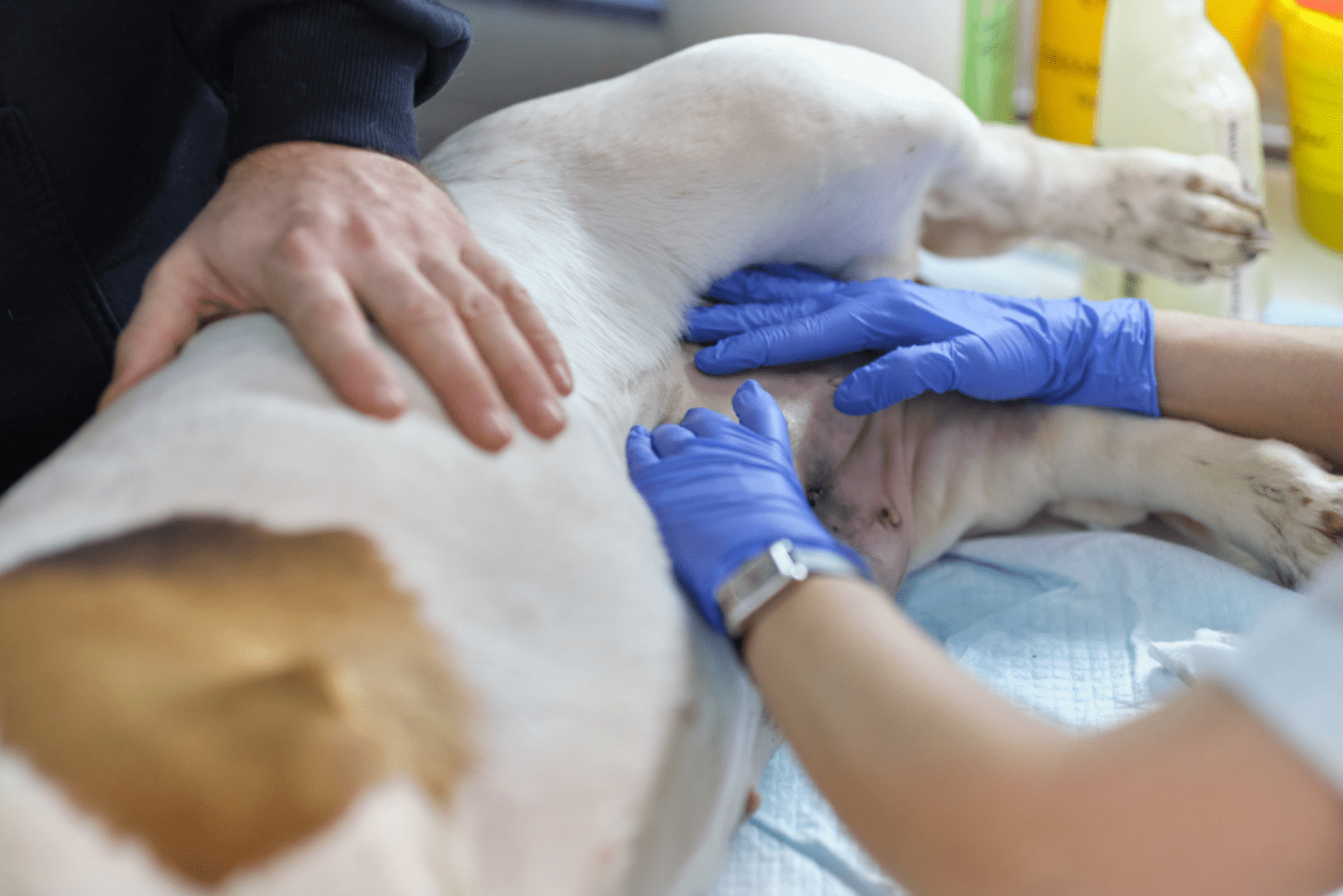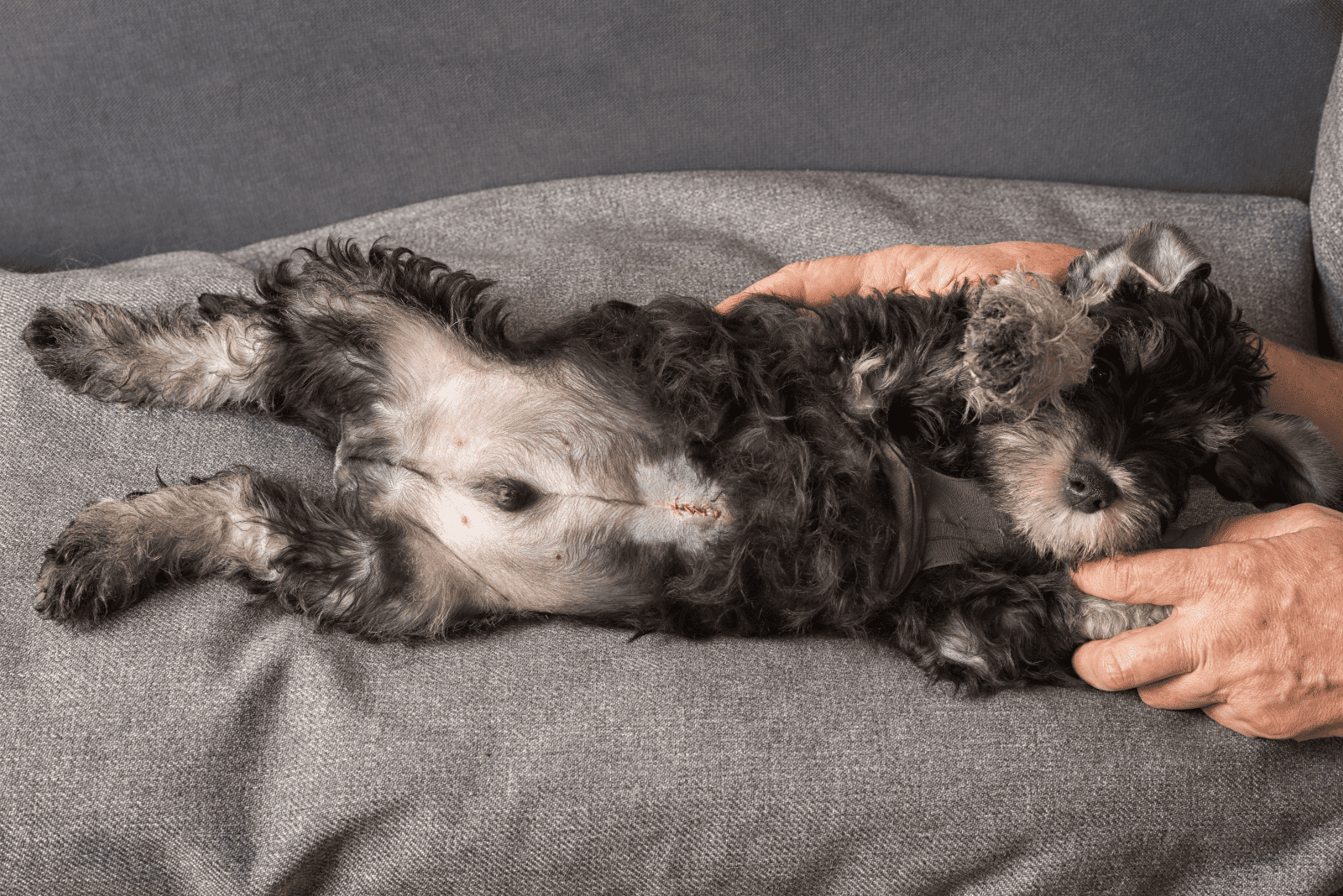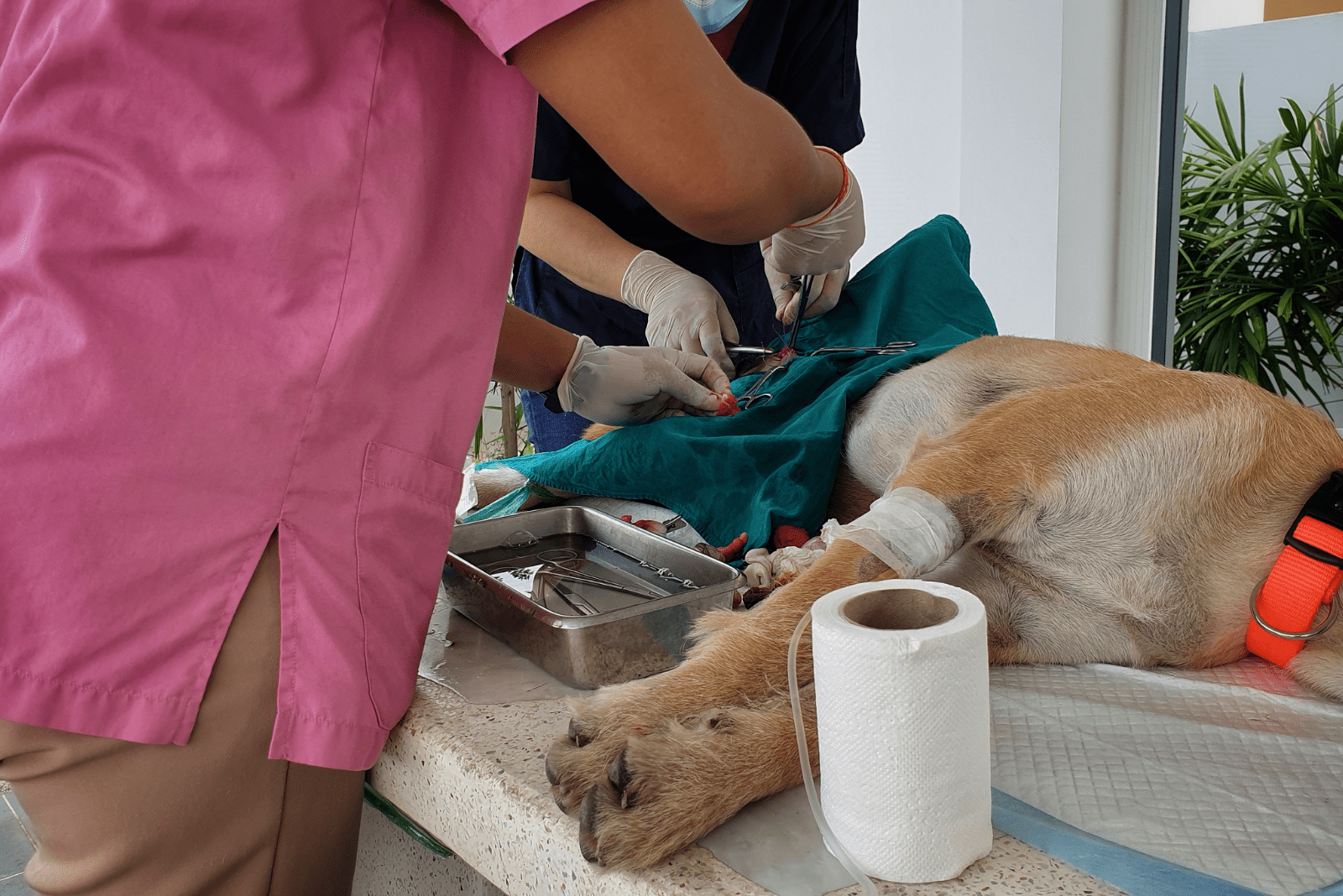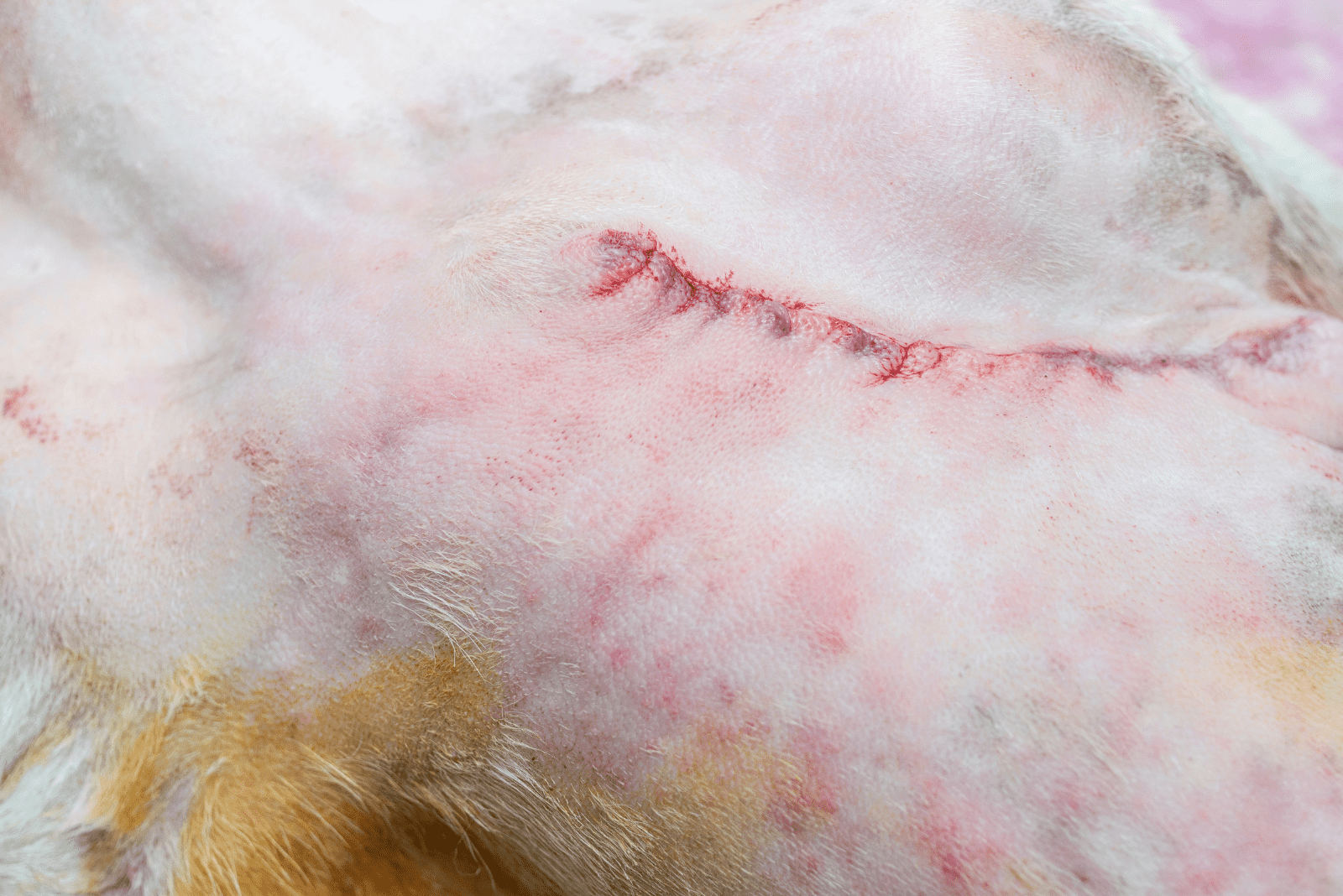Spaying or neutering, depending on the sex of your dog, has a key role in securing a healthy life for your dogster. It also puts your mind at ease if you are not planning on having your dog mate.
Any kind of surgery carries risk but spaying and neutering are done routinely so the prospect of complications is rather low.
You noticed a dog spay incision lump on your companion’s tummy? It is most likely not a cause for concern but a little more information is required to rule it out before rushing to the vet.
So, let us see what those bumps can be, how serious they are and how to prevent or make them disappear!
What Is A Seroma?
The usual suspect falling into the post-op “concern category“ is a dog spay/neuter incision lump. These can form on the incision line where the sutures are or, sometimes, on the edge. Most frequently they end up being seromas.
A seroma is an accumulation of serous fluid outside of the blood flow pathways. What does this fluid contain? The content is mostly supportive elements for blood such as high concentrations of protein (albumin and globulin) and water.
Serous fluids, basically, help carry nutrients for absorption or waste for excretion. What makes it special is the lack of red blood cell presence. This means that, unlike plasma, a seroma does not contain clotting factors. That is why the fluid can cause the wound to open but does not clot.
Is It A Normal Occurrence After Spaying Or Neutering?

Dog spay incision lumps are a moderately common occurrence after surgery. The procedure involves removal of internal organs, and seromas may develop during the post-operative period.
Seromas have a one in ten rate of occurrence. While it is a somewhat high percentage for the dog population it, in a large majority of cases, either resolves on its own or, in case the vet used a closed suction drain, is drained out of the seroma.
There are several types of closed suction drains and each has a different rate of post-op seroma occurrence. Drains have a preventative role and a couple of days after the surgical procedure, you will have to visit the vet to remove them.
Where, Why And How It Forms
The type of incision used in spaying (Ventral midline coeliotomy or abdominal wall incision) has a higher predisposition to cause seromas in a dog. However, with male dogs and neutering, the incision is scrotal so the risk is lower but still a possibility.
After the surgical procedure, veterinarians can use different suturing techniques to close the incision. The quilting technique has shown superior results in terms of seroma post-op occurrence and pain intensity compared to non-quilting.
Seromas can also occur internally and can be asymptomatic but, due to the physiological nature of the condition, it can dissolve itself and the fluid reabsorbed into the system.
This, most often, occurs, due to physical activity immediately after surgery. The healing period, in which dog activity should be kept to a minimum, lasts 7-10 days. Keeping an eye on your companion and refraining it from any intense physical exercise is crucial for a swift recovery.
There is also a possibility that the vet surgeon caused excessive trauma to the body by creating a longer than necessary cut or by applying too much force that results in serous formation.
Spotting And Diagnosing A Seroma
Home “diagnosing” is not difficult if it is a case of dog’s seroma but should never be a definitive way of concluding the examination. After checking the lump out, call your vet for advice and how to proceed next.
As a first step of diagnosing at home, look for a transparent or light–yellowish liquid secretion from the lump. The surrounding hair (if the dog’s coat is light-colored) will often assume a similar color.
The next step would be determining the consistency of the fluid – if slightly more viscous than water, with the previously mentioned color, chances are high it is a seroma.
If there is no liquid coming out of the lump, palpation (determining the softness or hardness of the formation) can be performed. If you notice your dog displaying sensitivity and/or pain while touching the lump, stop and immediately take it to a veterinarian.
If You Prefer To Take It To The Vet
To exclude any other pathology, if you see signs of pain or discomfort on your dog, taking it to the veterinarian is a smart choice. Although the vet will probably explain the possible post-surgery reactions and side effects before discharging the dog, you can never be too cautious.
At the animal hospital or vet station, they will, too, perform a palpation examination, followed by fluid extraction for laboratory analysis and, if necessary, some scans to rule out internal seromas.
Things That Can Look Similar To Seromas

Sometimes, harmless looking lumps can be signs of more complicated underlying health problems. In those situations a prompt vet visit is crucial for the safety of the dog.
We will see what other conditions can hide under the appearance of a lump, what other symptoms the dog might display along with main treatment options.
Hematoma
Simply because the skin is the outermost layer always in contact with external influences, injuries to it can cause lumps to form on the surface of the epithelium.
The difference between a hematoma and seroma is in the fluid that leaks out from ruptured blood vessels. Hematomas are all blood. A burst capillary will ooze blood into the surrounding cavities and fill any that are available.
While hematomas can occur virtually anywhere in or on the body, they most frequently form in places where capillaries are in abundances. Ears are a favorite among hematomas and are the most commonly occurring hematoma type in dogs.
Still, there is a possibility of a hematoma forming on the spaying or neutering incision. In this case, it will feel painful (much like a blister) and be quite sore. The dog might have discomfort while moving, sitting or lying on that part of the body and should be taken to a professional.
Treatment usually includes surgical removal or drainage of the clot, followed by precise suturing to close the wound. Prior to that and if needed, the vet might insert a drain pump to prevent recurring accumulation of fluid during the recovery period.
Hernia
Just like humans, dogs can have hernias too. The causes can be variable and are no less unpleasant than in our bodies.
A hernia is kind of nasty when you think about it – an organ protruding through the muscle tissue of your four legged friend? No one would want that to happen.
If it does happen it will definitely cause discomfort and pain to your dog. It might look similar to a seroma but will feel differently under the finger. I do not advise touching it as the dog will likely express its pain quite obviously.
Smaller hernias might not cause pain to your dog but if persistent, even after the healing period, definitely pay a visit to the vet. Though a rare occurrence after spaying, and especially neutering, they can happen.
The flexible disposition of fat, squeezing through the muscle tissue layers and through the incision area, can make the hernia grow larger. Increased protrusion can happen for several reasons, for example, physical strain, injury or stress.
If the hernia is small, the protrusion might not require surgical procedures but if the vet deems it necessary, the hernia might be operated on.
Abscess
These, something like the previous two conditions, can form in any part of the body. When speaking in the context of spaying or neutering, abscesses are by and large subcutaneous. This means that they occur under the skin.
Instead of serous fluid or blood, abscesses are filled with pus build-up. It is a “cocktail” of defunct cells, bacteria and dead tissue. Easily detectable by its density and foul smell, an abscess can occur if the incision line becomes infected during or immediately after the procedure.
As soon as bacteria get involved, that means infection problems. This, in turn, requires antibiotics therapy and sometimes, if the abscess is caused by a foreign object in the dog’s body, surgical removal.
This is why, in most cases, vets take on a proactive stance by prescribing topical or oral antibiotics
The type of bacteria will command the course of the treatment i.e. which type of antibiotic will be prescribed by your veterinarian. This usually means home treatment with a follow-up or two.
Tumor
This is a difficult one to explain. Any cell in the dog’s body can become cancerous. What causes cancer is still unknown to us and it makes diagnosis that much harder. Surgical procedures on a female dog are highly unlikely to cause cancer.
Serous effusions can be characterized as either benign or malignant. A benign effusion will result in a benign growth or tumor. This means the cancerous cells are not invasive and therefore will not spread.
A malignant effusion creates malignant growths and the cells in the fluid are invasive which means it will spread. If you do see a lump that does not look or feel like any of the previous conditions, then it could be a mast cell tumor.
Cancer of the reproductive system is one of the main reasons for spaying your dog. Male dog owners neuter to lower chances of testicular cancer. However, the surgical site, that soon after the operation, should not have sudden growths that result in tumors.
A tumor requires time to form a mass, and diagnosing it simply by physical examination is nearly impossible. The incision site cannot develop a visible cancerous mass in that short of a period.
Pet owners should still have their dog checked by a vet if they see unexpected or strange growths around the surgical incision.
Neuter And Spay Surgery Procedures And Alternatives

Visualizing a procedure before it happens helps a lot of patients. Since your dog cannot visualize it I will try and explain the process to you, just to avoid panicking the dog.
There are two types of surgical sterilization differentiated by the sex of the dog.
– Spaying (Ovariohysterectomy) includes the removal of a female dog’s ovaries, uterus and fallopian tubes. After spaying, the dog will not be able to breed. In addition, the procedure will get rid of the heat cycle and reproduction instincts.
There are other spay procedures that mainly differ in the number of reproductive organs removed. Those include partial removal of fallopian tubes and the uterus (hysterectomy) or only the removal of the ovaries (ovariectomy).
– Neutering (orchiectomy) is, simply, the removal of a male dog’s testes. Instinctual procreative behavior can be completely suppressed or toned down.
An alternative would be vasectomy which leaves the testes intact and only removes the sperm canals (vas deferens).
Alternative procedures that do not include hormone producing organs removal do not remove instinctual breeding behavior (orchiectomy and hysterectomy).
The Standard Surgery Process
Ovariohysterectomy
Before surgery, the veterinarian will perform blood tests to determine if the dog will be able to endure the anesthetic and surgery itself.
A spay procedure begins by the administration of general anesthesia. The amount administered depends on your dog’s weight and size. After the dog is unconscious, the surgeon will shave and clean the area before marking where the incision will be.
Since the dog cannot breathe on its own after the anesthetic is administered, a breathing tube will be inserted into the windpipe. This also makes sure the anesthetic has a direct way into the lungs.
The incision is made just below the umbilicus (belly button) and, that way, the surgeon can reach the ovaries, uterus and fallopian tubes.
The next step after removing the reproductive organs is suturing the incision. Suture material is a choice veterinarians make.
Some will use an absorbable suture so that you can skip visiting the vet for removal while others use non-absorbable ones. The latter requires returning to the vet for suture extraction.
Orchiectomy
The procedure is the same except the incision site and organs removed. With male dogs, the surgical incision is made slightly prior to the scrotum.
Since the removal of testicles is done without invasive (internal) methods, the next step consists of extracting the testicles through the freshly made incision. This procedure is even less complicated than spaying and has even fewer chances of complication.
Post-Surgery Care Tips
Certain dog breeds, especially those who are highly active and energetic require more monitoring in the post-operative period. Pet parents must put an e-collar (Elizabethan collar) on their dog to prevent them from biting and licking the wound.
The vet will prescribe NSAID pain medication. If your dog whimpers or shows signs of pain even while taking the medication take it to an animal hospital or the DVM who performed the surgery.
Depending on the overall dog’s health, age, breed and owner care, the pain might last for a few days or a couple of weeks. I recommend you check our article on how long a male dog will be in pain after neutering.
If excessive scar tissue starts to form, do not remove it dry. Try using lukewarm compresses to soften them until they fall off. If they are not coming off, try gently rubbing with a towel without applying pressure.
Pus discharge from the incision site or the wound still being open after two weeks is a sign of infection. Immediately go to your DVM or animal hospital if that is the case.
Length Of The Healing Process
It takes around ten to fourteen days for the incision to close. Your mileage may vary depending on the dog’s natural ability to heal and the rigorousness of the rehab process. Running, swimming and high-octane activities are out of the question. Wait for your vet’s approval.
Do not bathe your dog or let it get into any kind of water. It can soften the scar tissue and skin around it, causing the sutures to break. Non-sterile water and an open wound do NOT go well together.
Make sure you feed your dog a softer diet so that it does not strain while having a bowel movement. Also, keep in mind that, without activity, dogs tend to gain weight fast, and two weeks or so of eating too much can put unnecessary pressure on the incision.
Closing Words
Dog surgery is serious business and should not be taken lightly despite being a routine procedure. If you plan on taking your dog for a spay/neuter procedure make sure you know which procedure you wish to go with. They all cost different amounts of money.
If you notice a dog spay incision lump, be calm, assess the situation and remember what we talked about in the article.
Prepare for your dog’s post-op recovery in advance. Plan things out so you do not leave it unattended or all hell will break loose. If you have small children, teach them to be careful with the dog and to not entice it into playing.
Finally, always have your vet on speed dial, whether for emergencies or uncertainty over recovery. They just love dog owners who call in the middle of the night!
Read Next:
• How Will My Female Dog’s Behavior Change After Spaying?
• My Dog Jumped After Being Spayed, So I Did These 4 Things
• How Serious A Lump On Dogs’ Tail Can Be: 9 Explanations
